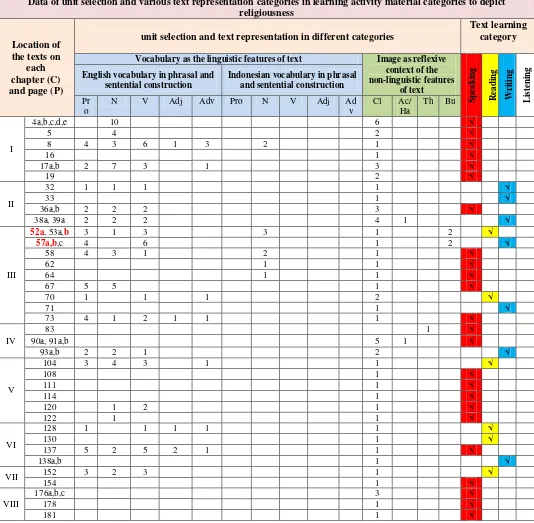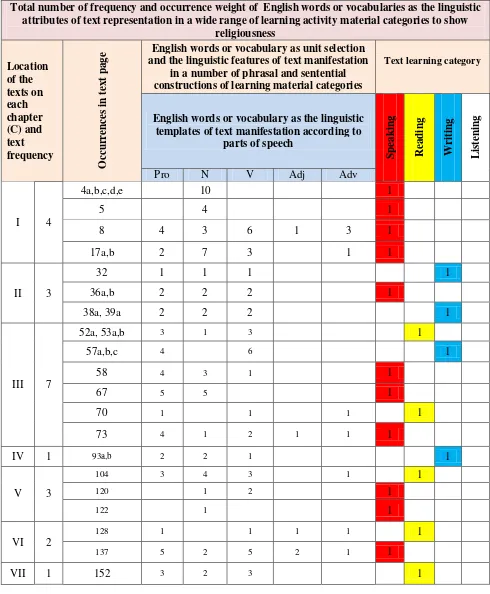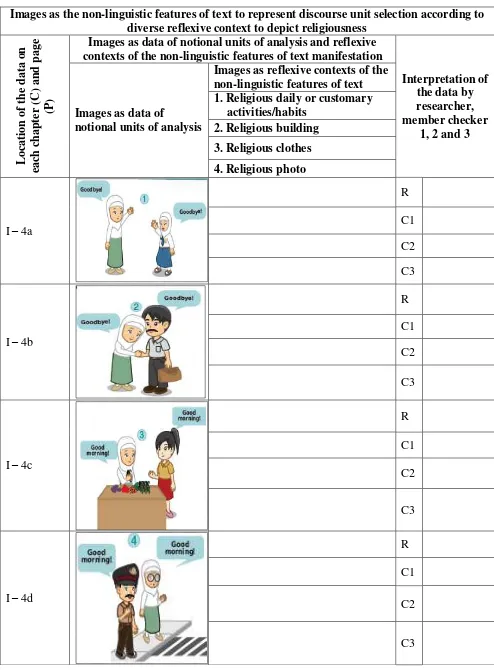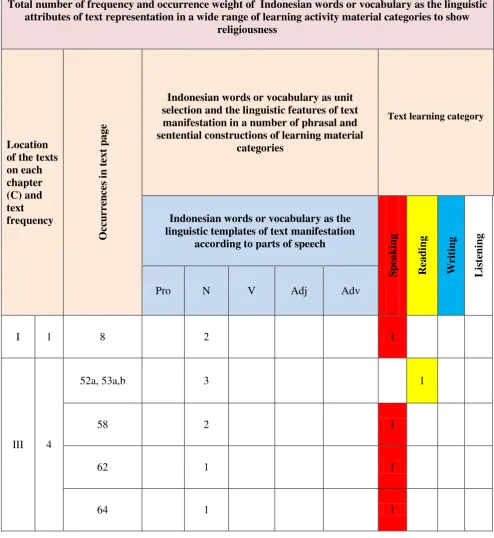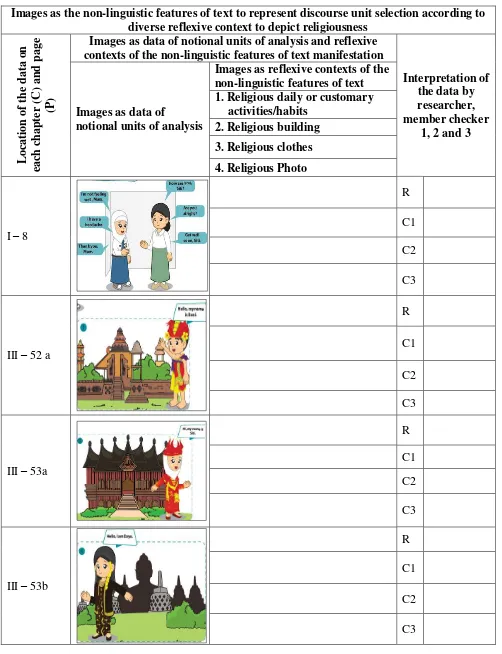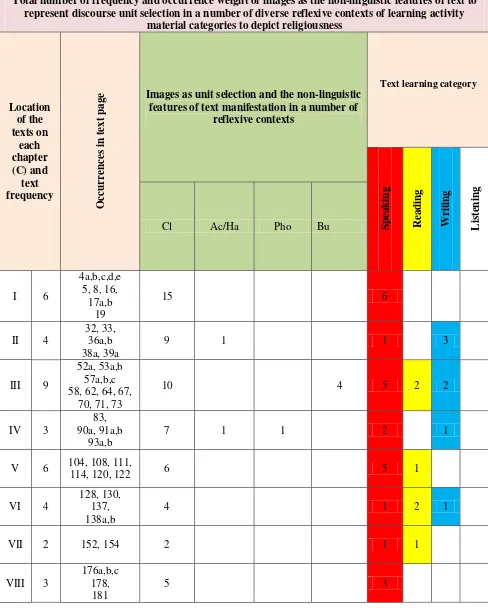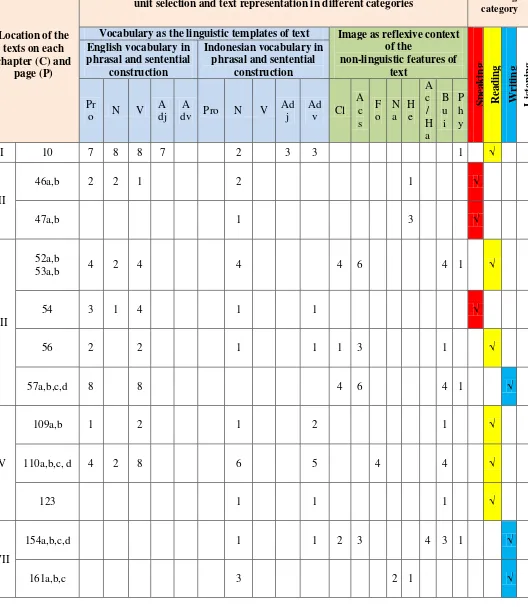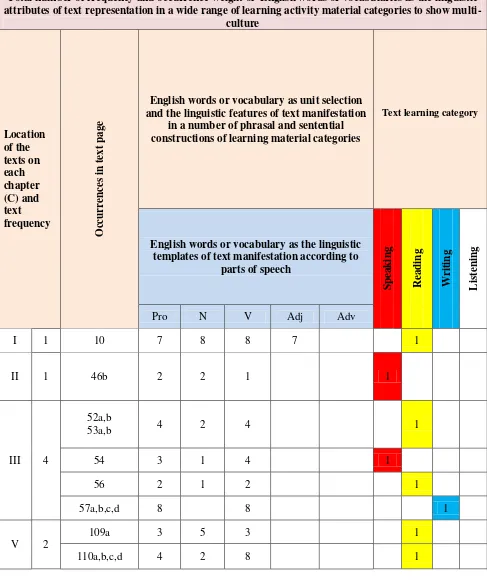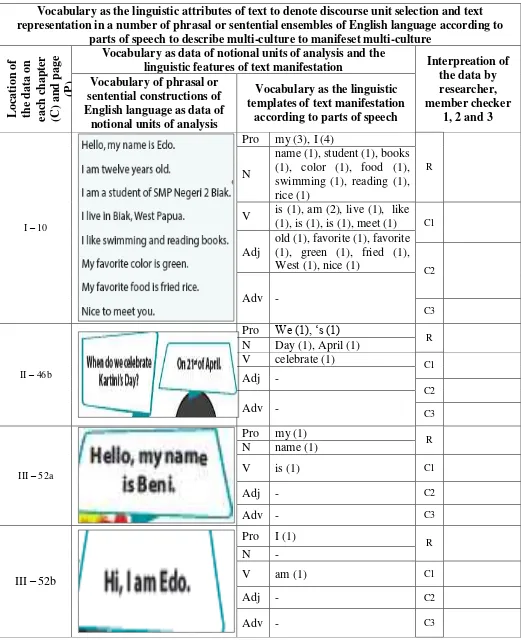Table 4.1.3 – The table below shows words or vocabulary as the linguistic templates and image as reflexive context of the non-linguistic templates of texts to depict discourse of religiousness,
Data of unit selection and various text representation categories in learning activity material categories to depict religiousness
Location of the texts on
each chapter (C) and page (P)
unit selection and text representation in different categories
Text learning category
Vocabulary as the linguistic features of text Image as reflexive context of the non-linguistic features of text S p ea k in g Re a d in g Wr iti n g Liste n in g
English vocabulary in phrasal and sentential construction
Indonesian vocabulary in phrasal and sentential construction
Pr o
N V Adj Adv Pro N V Adj Ad
v
Cl Ac/ Ha
Th Bu
I
4a,b,c,d,e 10 6 √
5 4 2 √
8 4 3 6 1 3 2 1 √
16 1 √
17a,b 2 7 3 1 3 √
19 2 √
II
32 1 1 1 1 √
33 1 √
36a,b 2 2 2 3 √
38a, 39a 2 2 2 4 1 √
III
52a, 53a,b 3 1 3 3 1 2 √
57a,b,c 4 6 1 2 √
58 4 3 1 2 1 √
62 1 1 √
64 1 1 √
67 5 5 1 √
70 1 1 1 2 √
71 1 √
73 4 1 2 1 1 1 √
IV
83 1 √
90a, 91a,b 5 1 √
93a,b 2 2 1 2 √
V
104 3 4 3 1 1 √
108 1 √
111 1 √
114 1 √
120 1 2 1 √
122 1 1 √
VI
128 1 1 1 1 1 √
130 1 √
137 5 2 5 2 1 1 √
138a,b 1 √
VII 152 3 2 3 1 √
154 1 √
VIII
176a,b,c 3 √
178 1 √
wide range of learning activity material categories to show religiousness,
Total number of frequency and occurrence weight of English words or vocabularies as the linguistic attributes of text representation in a wide range of learning activity material categories to show
religiousness Location of the texts on each chapter (C) and text frequency O cc u rr en ce s in t ext p age
English words or vocabulary as unit selection and the linguistic features of text manifestation
in a number of phrasal and sentential constructions of learning material categories
Text learning category
English words or vocabulary as the linguistic templates of text manifestation according to
parts of speech
Sp eaki ng R eadi ng Wri ti ng L ist ening
Pro N V Adj Adv
I 4
4a,b,c,d,e 10 1
5 4 1
8 4 3 6 1 3 1
17a,b 2 7 3 1 1
II 3
32 1 1 1 1
36a,b 2 2 2 1
38a, 39a 2 2 2 1
III 7
52a, 53a,b 3 1 3 1
57a,b,c 4 6 1
58 4 3 1 1
67 5 5 1
70 1 1 1 1
73 4 1 2 1 1 1
IV 1 93a,b 2 2 1 1
V 3
104 3 4 3 1 1
120 1 2 1
122 1 1
VI 2
128 1 1 1 1 1
137 5 2 5 2 1 1
religiousness,
Images as the non-linguistic features of text to represent discourse unit selection according to diverse reflexive context to depict religiousness
L
oc
ation
of t
h
e d
ata o
n
eac
h
c
h
ap
te
r (
C)
an
d
p
age
(P
)
Images as data of notional units of analysis and reflexive contexts of the non-linguistic features of text manifestation
Interpretation of the data by researcher, member checker
1, 2 and 3 Images as data of
notional units of analysis
Images as reflexive contexts of the non-linguistic features of text 1. Religious daily or customary
activities/habits 2. Religious building 3. Religious clothes 4. Religious photo
I – 4a
R
C1
C2
C3
I – 4b
R
C1
C2
C3
I – 4c
R
C1
C2
C3
I – 4d
R
C1
C2
I – 4e
C1
C2
C3
I – 5
R
C1
C2
C3
I – 8
R
C1
C2
C3
I – 17a
R
C1
C2
C3
I – 17b
R
C1
C2
C3
II – 32
R
C1
C2
II – 36a
C1
C2
C3
II – 36b
R
C1
C2
C3
II – 38a
R
C1
C2
C3
II – 39a
R
C1
C2
C3
III – 52 a
R
C1
C2
C3
III – 53a
R
C1
C2
III – 53b
C1
C2
C3
III – 57a
R
C1
C2
C3
III – 57b
R
C1
C2
C3
III – 57c
R
C1
C2
C3
III – 58
R
C1
C2
C3
III – 67
R
C1
C2
III – 70
C1
C2
C3
III – 73
R
C1
C2
C3
IV – 93a
R
C1
C2
C3
IV – 93b
R
C1
C2
C3
V – 104
R
C1
C2
C3
V – 120
R
C1
C2
V – 122 C1 C2
C3
VI – 128
R
C1
C2
C3
VI – 137
R
C1
C2
C3
VII - 152
R
C1
C2
a wide range of learning activity material categories to show religiousness,
Total number of frequency and occurrence weight of Indonesian words or vocabulary as the linguistic attributes of text representation in a wide range of learning activity material categories to show
religiousness
Location of the texts on each chapter (C) and text frequency
O
cc
u
rr
en
ce
s
in t
ext
p
age
Indonesian words or vocabulary as unit selection and the linguistic features of text
manifestation in a number of phrasal and sentential constructions of learning material
categories
Text learning category
Indonesian words or vocabulary as the linguistic templates of text manifestation
according to parts of speech
Sp
eaki
ng
R
eadi
ng
Wri
ti
ng
L
ist
ening
Pro N V Adj Adv
I 1 8 2 1
III 4
52a, 53a,b 3 1
58 2 1
62 1 1
Images as the non-linguistic features of text to represent discourse unit selection according to diverse reflexive context to depict religiousness
L
oc
ation
of t
h
e d
ata o
n
eac
h
c
h
ap
te
r (
C)
an
d
p
age
(P
)
Images as data of notional units of analysis and reflexive contexts of the non-linguistic features of text manifestation
Interpretation of the data by researcher, member checker
1, 2 and 3 Images as data of
notional units of analysis
Images as reflexive contexts of the non-linguistic features of text 1. Religious daily or customary
activities/habits 2. Religious building 3. Religious clothes 4. Religious Photo
I – 8
R
C1
C2
C3
III – 52 a
R
C1
C2
C3
III – 53a
R
C1
C2
C3
III – 53b
R
C1
C2
III – 58
C1
C2
C3
III – 62
R
C1
C2
C3
III – 64
R
C1
C2
Total number of frequency and occurrence weight of images as the non-linguistic features of text to represent discourse unit selection in a number of diverse reflexive contexts of learning activity
material categories to depict religiousness
Location of the texts on each chapter (C) and text frequency O cc u rr en ce s in t ext p age
Images as unit selection and the non-linguistic features of text manifestation in a number of
reflexive contexts
Text learning category
Sp eaki ng R eadi ng Wri ti ng L ist ening
Cl Ac/Ha Pho Bu
I 6
4a,b,c,d,e 5, 8, 16,
17a,b 19
15 6
II 4
32, 33, 36a,b 38a, 39a
9 1 1 3
III 9
52a, 53a,b 57a,b,c 58, 62, 64, 67,
70, 71, 73
10 4 5 2 2
IV 3
83, 90a, 91a,b
93a,b
7 1 1 2 1
V 6 104, 108, 111,
114, 120, 122 6 5 1
VI 4
128, 130, 137, 138a,b
4 1 2 1
VII 2 152, 154 2 1 1
VIII 3
176a,b,c 178,
181
to depict religiousness,
Images as the non-linguistic features of text to represent discourse unit selection according to diverse reflexive context to depict religiousness
L
oc
ation
of t
h
e d
ata o
n
eac
h
c
h
ap
te
r (
C)
an
d
p
age
(P
)
Images as data of notional units of analysis and reflexive contexts of the non-linguistic features of text manifestation
Interpretation of the data by researcher, member checker
1, 2 and 3 Images as data of
notional units of analysis
Images as reflexive contexts of the non-linguistic features of text 1. Religious daily or customary
activities/habits 2. Religious building 3. Religious clothes 4. Religious photo
I – 4a
R
C1
C2
C3
I – 4b
R
C1
C2
C3
I – 4c
R
C1
C2
C3
I – 4d
R
C1
C2
I – 4e
C1
C2
C3
I – 5
R
C1
C2
C3
I – 8
R
C1
C2
C3
I – 16
R
C1
C2
C3
I – 17a
R
C1
C2
C3
I – 17b
R
C1
C2
I – 19
C1
C2
C3
II – 32
R
C1
C2
C3
II – 33
R
C1
C2
C3
II – 36a
R
C1
C2
C3
II – 36b
R
C1
C2
C3
II – 38a
R
C1
C2
II – 39a
C1
C2
C3
III – 52 a
R
C1
C2
C3
III – 53a
R
C1
C2
C3
III – 53b
R
C1
C2
C3
III – 57a
R
C1
C2
C3
III – 57b
R
C1
C2
III – 57c
C1
C2
C3
III – 58
R
C1
C2
C3
III – 62
R
C1
C2
C3
III – 64
R
C1
C2
C3
III – 67
R
C1
C2
C3
III – 70
R
C1
C2
III – 71
C1
C2
C3
III – 73
R
C1
C2
C3
IV – 83
R
C1
C2
C3
IV – 90a
R
C1
C2
C3
IV – 91a
R
C1
C2
C3
IV – 91b
R
C1
C2
IV – 93a
C1
C2
C3
IV – 93b
R
C1
C2
C3
V – 104
R
C1
C2
C3
V – 108
R
C1
C2
C3
V – 111
R
C1
C2
C3
V – 114
R
C1
C2
V – 120
C1
C2
C3
V – 122
R
C1
C2
C3
VI – 128
R
C1
C2
C3
VI – 130
R
C1
C2
C3
VI – 137
R
C1
C2
C3
VI – 138a
R
C1
C2
VI – 138b
C1
C2
C3
VII - 152
R
C1
C2
C3
VII – 154
R
C1
C2
C3
VIII – 176a
R
C1
C2
C3
VIII – 176b
R
C1
C2
C3
VIII – 176c
R
C1
C2
VIII – 178
C1
C2
C3
VIII – 181
R
C1
C2
–
reflexive context of the non-linguistic templates of texts to illustrate discourse of multi-culture,
Data of unit selection and various text representation categories in learning activity material categories to depict multi-culture
Location of the texts on each chapter (C) and
page (P)
unit selection and text representation in different categories
Text learning category Vocabulary as the linguistic templates of text Image as reflexive context
of the
non-linguistic features of text Sp eaki ng R eadi ng Wri ti ng L ist ening
English vocabulary in phrasal and sentential
construction
Indonesian vocabulary in phrasal and sentential
construction
Pr
o N V
A dj
A
dv Pro N V
Ad j
Ad
v Cl
A c s F o N a H e A c / H a B u i P h y
I 10 7 8 8 7 2 3 3 1 √
II
46a,b 2 2 1 2 1 √
47a,b 1 3 √
III
52a,b
53a,b 4 2 4 4 4 6 4 1 √
54 3 1 4 1 1 √
56 2 2 1 1 1 3 1 √
57a,b,c,d 8 8 4 6 4 1 √
V
109a,b 1 2 1 2 1 √
110a,b,c, d 4 2 8 6 5 4 4 √
123 1 1 1 √
VII
154a,b,c,d 1 1 2 3 4 3 1 √
Total number of frequency and occurrence weight of English words or vocabularies as the linguistic attributes of text representation in a wide range of learning activity material categories to show
multi-culture
Location of the texts on each chapter (C) and text frequency
O
cc
u
rr
en
ce
s
in t
ext
p
age
English words or vocabulary as unit selection and the linguistic features of text manifestation
in a number of phrasal and sentential constructions of learning material categories
Text learning category
English words or vocabulary as the linguistic templates of text manifestation according to
parts of speech
Sp
eaki
ng
R
eadi
ng
Wri
ti
ng
L
ist
ening
Pro N V Adj Adv
I 1 10 7 8 8 7 1
II 1 46b 2 2 1 1
III 4
52a,b
53a,b 4 2 4 1
54 3 1 4 1
56 2 1 2 1
57a,b,c,d 8 8 1
V 2
109a 3 5 3 1
sentential ensembles of English language according to parts of speech to describe multi-culture,
Vocabulary as the linguistic attributes of text to denote discourse unit selection and text representation in a number of phrasal or sentential ensembles of English language according to
parts of speech to describe multi-culture to manifeset multi-culture
L oc ation of the d ata o n eac h c h ap te r (C ) and p age (P )
Vocabulary as data of notional units of analysis and the
linguistic features of text manifestation Interpreation of the data by researcher, member checker
1, 2 and 3 Vocabulary of phrasal or
sentential constructions of English language as data of
notional units of analysis
Vocabulary as the linguistic templates of text manifestation
according to parts of speech
I – 10
Pro my (3), I (4)
R N
name (1), student (1), books (1), color (1), food (1), swimming (1), reading (1), rice (1)
V is (1), am (2), live (1), like (1), is (1), is (1), meet (1) C1
Adj
old (1), favorite (1), favorite (1), green (1), fried (1), West (1), nice (1) C2
Adv -
C3
II – 46b
Pro We (1), ‘s (1)
R N Day (1), April (1)
V celebrate (1)
C1 Adj -
C2 Adv -
C3
III – 52a
Pro my (1)
R N name (1)
V is (1) C1
Adj - C2
Adv - C3
III – 52b
Pro I (1)
R
N -
V am (1) C1
Adj - C2
III – 53a
N name (1)
V is (1) C1
Adj - C2
Adv - C3
III – 53b
Pro I (1)
R N -
V am (1) C1
Adj - C2
Adv - C3
III – 54
Pro your (1), I (2), you (1)
R N name (1)
V am (1), is (1), come (2) C1
Adj - C2
Adv - C3
III – 56
Pro my (1), I (1)
R N name (1)
C1 V is (1), come (1)
Adj - C2
Adv - C3
III – 57a
Pro he (2)
R N
C1 V is (1), comes (1)
Adj - C2
Adv - C3
III – 57b
Pro he (2)
R
N -
C1 V is (2)
Adj - C2
Adv - C3
III – 57c
Pro she (2)
R
N -
C1 V is (2)
Adj - C2
III – 57d
N -
C1 V is (1), comes (1)
Adj - C2
Adv - C3
V – 109a
Pro my (1), She (2) R
N
grandmother (1), cooking (1), restaurant (1), food (1),
city (1) C1
V likes (1), has (1), cooks (1)
Adj - C2
Adv - C3
V – 110a
Pro I (1) R
N Vegetables (1)
C1 V want (1), eat (1)
Adj fresh (1) C2
Adv - C3
V – 110b
Pro I (1)
R
N -
C1 V Want (1), eat (1)
Adj - C2
Adv - C3
V – 110c
Pro I (1)
R
N -
C1 V Want (1), eat (1)
Adj - C2
Adv - C3
V – 110d
Pro I (1) R
N Porridge (1)
C1 V Want (1), eat (1)
Adj - C2
Total number of frequency and occurrence weight of Indonesian words or vocabulary as the linguistic attributes of text representation in a wide range of learning activity material categories to
show multi-culture
Location of the texts on each chapter (C) and text frequency
O
cc
u
rr
en
ce
s
in t
ext
p
age
Indonesian words or vocabulary as unit selection and the linguistic features of text manifestation in a number of phrasal and sentential constructions of learning material
categories
Text learning category
Indonesian words or vocabulary as the linguistic templates of text manifestation
according to parts of speech
Sp
eaki
ng
R
eadi
ng
Wri
ti
ng
L
ist
ening
Pro N V Adj Adv
I 1 10 2 3 3 1
II 2
46a,b 2 1
47b 1 1
III 3
52a,b
53a,b 4 1
54 1 1 1
56 1 1 1
V 3
109a,b 1 2 1
110a,b,c, d 6 5 1
123 1 1 1
VII 2
154 1 1 1
sentential ensembles of Indonesian language according to parts of speech to describe multi-culture,
Vocabulary as the linguistic attributes of text to denote unit selection and text representation in a number of phrasal or sentential ensembles of Indonesian language according to parts of speech to
describe multi-culture to manifeset multi-culture
L oc ation of the d ata o n eac h c h ap te r (C ) and p age (P )
Vocabulary as data of notional units of analysis and the linguistic features of text manifestation
Interpretation of the data by researcher,
member checker 1, 2
and 3 Vocabulary of phrasal or
sentential constructions of Indonesian language as data of
notional units of analysis
Vocabulary as the linguistic templates of text manifestation according to
parts of speech
I – 10
Pro -
R
N Edo (1), S/Sekolah (1)
C1 V -
C2 Adj M/Menengah (1),
P/Pertama (1), Negeri (1)
C3 Adv Biak (2), Papua (1)
II – 46a
Pro -
R N Raden Ajeng Kartini (1)
C1 V -
C2 Adj -
C3 Adv -
II – 46b
Pro -
R N Kartini (1)
C1 V -
C2 Adj -
C3 Adv -
II – 47b
Pro -
R N Bung Tomo (1)
C1 V -
C2 Adj -
III – 52a
C1 V -
C2 Adj -
C3 Adv -
III – 52b
Pro -
R N Edo (1)
C1 V -
C2 Adj -
C3 Adv -
III – 53a
Pro -
R N Siti (1)
C1 V -
C2 Adj -
C3 Adv -
III – 53b
Pro -
R N Dayu (1)
C1 V -
C2 Adj -
C3 Adv -
III – 54
Pro -
R N Lina (1)
C1 V -
C2 Adj -
C3 Adv Medan (1)
III – 56
Pro -
R N Udin (1)
C1 V -
C2 Adj -
V – 109a
N -
C1 V -
C2 Adj -
C3 Adv Padang (1)
V – 109b
Pro -
R N Rumah Makan (1)
C1 V -
C2 Adj -
C3 Adv Padang (1)
V – 110a
Pro -
R N Sambal (1)
C1 V -
C2 Adj -
C3 Adv -
V – 110a
Pro -
R N Rumah makan (1)
V - C1
Adj - C2
Adv Sunda (1) C3
V – 110b
Pro -
R N Coto (1)
C1 V -
C2 Adj -
C3 Adv Makasar (1)
V – 110b
Pro -
R N Coto (1)
V - C1
Adj - C2
V – 110c
C1 V -
C2 Adj -
C3 Adv -
V – 110c
Pro
R N Rumah makan (1)
Verb C1
Adj C2
Adv Padang (1) C3
V – 110d
Pro -
R N -
C1 V -
C2 Adj -
C3 Adv Manado (1)
V – 110d
Pro -
R N Rumah makan (1)
C1 V -
C2 Adj -
C3 Adv Manado (1)
V – 123
Pro -
R N Rumah makan (1)
C1 V -
C2 Adj -
C3 Adv Padang (1)
VII - 154
Pro -
R N Rumah makan (1)
C1 V -
C2 Adj -
VII – 161a
N Baharudin Jusuf Habibie (1)
C1 V -
C2 Adj -
C3 Adv -
VII – 161b
Pro -
R N Joko Widodo (1)
C1 V -
C2 Adj -
C3 Adv -
VII – 161c
Pro -
R N Cut Nyak Dien (1)
C1 V -
C2 Adj -
Total number of frequency and occurrence weight of images as the non-linguistic features of text to represent unit selection in a number of diverse reflexive contexts of learning activity material categories to
depict multi-culture
Location of the texts on
each chapter (C) and
text frequency
O
cc
u
rr
en
ce
s
in
t
ext
p
age
Images as unit selection and the non-linguistic features of text manifestation in a number of reflexive
contexts
Text learning category
Cl Acs Fo Na He Ac/
Ha Bui Phy
Speaki
ng
R
ea
di
ng
Wr
it
ing
Lis
teni
ng
I 1 10 1 1
II 2
46a
4 2
47a,b
III 3
52a,b, 53a,b
9 15 9 2 1 2 1
56,
57a,b,c,d
V 3
109b,
4 6 3
110a,b,c,d,
123
VII 2 154a,b,c,d, 2 3 2 1 4 3 1 2
culture,
Images as the non-linguistic features of text to represent unit selection according to diverse reflexive context in an array of representation categories to depict multi-culture
L
oc
ation
of t
h
e d
ata o
n
e
ac
h
ch
ap
te
r (C
) and
p
age
(P
)
Images as data of notional units of analysis and reflexive contexts of the non-linguistic features of text manifestation
Interpretation of the data by researcher, member checker 1, 2 and 3
Images as data of notional units of analysis
Images as reflexive contexts of the non-linguistic features of text manifestation
1. clothes 2. accessories 3. food
4. “cultural-bounded” people name 5. heroes or heroines
6. daily/customary activities/habits 7. architectural building
8. bodily or physical look
I – 10
R
C1
C2
C3
II – 46a
R
C1
C2
C3
II – 47a
R
C1
C2
II – 47b
C1
C2
C3
III – 52a
R
C1
C2
C3
III – 52b
R
C1
C2
C3
III – 53a
R
C1
C2
III – 53b
C1
C2
C3
III – 56
R
C1
C2
C3
III – 57a
R
C1
C2
C3
III – 57b
R
C1
C2
III – 57c
C1
C2
C3
III – 57d
R
C1
C2
C3
V – 109
R
C1
C2
C3
V – 110a
R
C1
C2
V – 110b
C1
C2
C3
V – 110c
R
C1
C2
C3
V – 110d
R
C1
C2
C3
V – 123
R
C1
C2
VII – 154a
C1
C2
C3
VII – 154b
R
C1
C2
C3
VII – 154c
R
C1
C2
C3
VII – 154d
R
C1
C2
VII – 161a
C1
C2
C3
VII – 161b
R
C1
C2
C3
VII – 161c
R
C1
C2
In Catholic Junior High School of Santa Clara
The teacher preferred to several teaching strategies to develop the students’ religious competence and four English skills, say, problem-based learning, cooperative-learning strategy, project-based
learning, and task-based learning.
With problem-based learning to teach reading and speaking, the teacher introduced a topic of six
religious public places in Indonesia and made several students’ small groups. The teacher
distributed some pictures of six religious buildings, asked them to complete several lost information
of the pictures from the given answers in the bracket, and required them to match a series of
possible religious activities or habits and clothes in the brackets with the six religious building
pictures, and asked every member of the groups to communicate their work in the class.
With cooperative-based learning, the teacher formed the students into small group, distributed
listening worksheet related to English cartoon movies about Christmas, played the movies, and
asked each member of the groups to answer the questions of the worksheet and to rewrite the
general information of the movies. The teacher targeted this to teach listening and speaking.
The teacher also assigned the students to compose their Christmas celebration plan and devoted
to direct project-based learning to teach writing. Besides, the teacher organized task-based learning
by asking the students to pray in English when they had English subject and aimed this learning
strategy to teach speaking.
In Christian Junior High School of Aletheia
The teacher devoted to several teaching strategies to encourage the students’ their religious competence and four English skills, for instances, problem-based learning, cooperative-learning
strategy, project-based learning, and task-based learning.
With problem-based learning, the teacher shortly made introduction of a topic of six religious
pictures from the given answers in the bracket. The teacher also invited them to match a series of
possible religious activities or habits and clothes in the brackets with the six religious building
pictures and instructed every member of the groups to present their work in front of the class. The
teacher outlined the problem-based learning to teach reading and speaking.
The teacher grouped the students into several small divisions, shared listening worksheet related
to English cartoon movies about Christmas, played the movies, and assigned each member of the
group to answer the questions of the worksheet and to rewrite the general information of the
movies. The teacher applied cooperative-based learning to teach listening and speaking.
With project-based learning, the teacher assigned the students to make composition about their
Christmas activity schedule and aimed this to teach writing. Furthermore, the teacher carried out
task-based learning by asking the students to pray in English when they had English subject and
addressed this learning strategy to teach speaking.
In Islamic Junior High School of Raden Paku
The teacher adhered to several teaching strategies to enhance the students’ their religious competence and four English skills, for instances, problem-based learning, cooperative-learning
strategy, project-based learning, and task-based learning.
With problem-based learning, the teacher gave a short topical highlight of six religious public
places in Indonesia and divided several students into small groups. The teacher equipped them with
some pictures of six religious buildings and directed them to complete several lost information of
the pictures from the given answers in the bracket. The teacher also asked them to find out a series
of proper matches of several religious activities or habits and clothes in the brackets with the six
religious building pictures. The teacher, then, instructed every member of the groups to present their
work in front of the class and organized the problem-based learning to teach reading and speaking.
The teacher also grouped the students into small classes, shared listening worksheet related to
With project-based learning, the teacher got the students to make composition about their own
religious celebration, and planned this to teach writing. Besides, the teacher followed task-based
learning by asking the students to pray in English when they had English subject and addressed this
learning strategy to teach speaking.
In State Junior High School of 49
The teacher followed several teaching strategies to enable the students to augment their religious
competence and four English skills, namely, problem-based learning, cooperative-learning strategy,
project-based learning, and task-based learning.
With problem-based learning, the teacher presented shortly a topic of six religious public places
in Indonesia and categorized several students into small groups. The teacher provided some pictures
of six religious buildings and assigned them to complete several lost information of the pictures
from the given answers in the bracket. Next, the teacher invited them to look for a series of possible
religious activities or habits and clothes in the brackets to be congruent with the six religious
building pictures and instructed every member of the groups to present their work in front of the
class. The teacher administered the problem-based learning to teach reading and speaking.
The teacher made the students into small groups, distributed listening worksheet related to short
recorders about six religious buildings in Indonesia, played the recorders, and asked the members of
the group to find out the correct answers of the questions of the worksheet and to present their own
work. The teacher intended cooperative-based learning to teach listening and speaking.
The teacher also instructed the students to make composition about their own religious
celebration plan, and meant project-based learning to teach writing. The teacher also introduced
task-based learning by asking the students to pray in English when they had English subject, and
“When English Rings the Bell”
In Catholic Junior High School of Santa Clara
The teacher outlined teaching strategies to develop the students’ multi-cultural competence and four English skills, say, problem-based, project-based and service learning.
With problem-based learning, the teacher provided a general introduction of a topic related to
several public places of multi-culture in Indonesia and made several students’ small groups. The teacher distributed some pictures of the places and asked them to select several lost information of
the pictures from the given answers in the bracket. The teacher also required them to match a series
of possible multi-cultural activities or habits, accessories, food, cultural bounded people name, local
heroes/heroines, architectural buildings, and clothes in the brackets with the outlined pictures of the
multi-cultural public places, and invited every member of the groups to communicate their work in
front of the class. The teacher managed the problem-based learning to teach reading and speaking.
The teacher also assigned the students to browse some information of several pictures of certain
multi-cultural public places from the internet and to make their own composition, and prescribed
project-based learning to teach writing.
Furthermore, the teacher organized service learning by asking the students to participate in
English contests with Indonesian multi-cultural dressing code to teach speaking. Sometimes, the
teacher also set out dictation model by telling several descriptions of multi-cultural public places,
asked the students to decide the right pictures based on the dictated scripts and managed this
strategy to teach listening.
In Christian Junior High School of Aletheia
The teacher administered teaching strategies to build the students’ multi-cultural competence and four English skills, e.g. problem-based, project-based, and service learning.
With problem-based learning, the teacher provided a general introduction of a topic related to
series of possible multi-cultural activities or habits, accessories, food, cultural bounded people
name, local heroes/heroines, architectural buildings, and clothes in the brackets with the outlined
pictures of the multi-cultural public places, and invited every member of the groups to communicate
their work in front of the class. The teacher managed the problem-based learning to teach reading
and speaking.
The teacher also assigned the students to browse some information of several pictures of certain
multi-cultural public places in Indonesia from the internet and instructed them to make their own
composition. The teacher prescribed project-based learning to teach writing.
The teacher used service learning by asking the students to join English contests with Indonesian
multi-cultural dressing code to teach speaking. Sometimes, the teacher also prepared dictation
model by telling several descriptions of multi-cultural public places, asked the students to determine
the right pictures according to the dictated scripts and designed this strategy to teach listening.
In Islamic Junior High School of Raden Paku
The teacher pursued teaching strategies to encourage the students’ multi-cultural competence and four English skills, say, problem-based, project-based and service learning.
With problem-based learning, the teacher provided a general introduction of a topic of several
public places of multi-culture in Indonesia and grouped several students into small classes. The
teacher distributed some pictures of the places and asked them to select several lost information of
the pictures from the given answers in the bracket. The teacher also instructed them to match a
series of possible multi-cultural activities or habits, accessories, food, cultural bounded people
name, local heroes/heroines, architectural buildings, and clothes in the brackets with the outlined
pictures of the multi-cultural public places, and invited every member of the groups to present their
work in front of the class. The teacher focused on the problem-based learning to teach reading and
certain multi-cultural public places from the internet and instructed them to make their own
composition. The teacher concentrated on project-based learning to teach writing.
The teacher used service learning by asking the students to join English contests with Indonesian
multi-cultural dressing code to teach speaking. Sometimes, the teacher also prepared dictation
model by telling several descriptions of multi-cultural public places, asked the students to determine
the right pictures according to the dictated scripts and designed this strategy to teach listening.
In State Junior High School of 49
The teacher proposed teaching strategies to enable the students to foster their multi-cultural
competence and four English skills e.g. problem-based, project-based and service learning.
With problem-based learning, the teacher gave a general introduction of a topic of several public
places of multi-culture in Indonesia and split several students into small groups. The teacher
distributed some pictures of the places and asked them to select several lost information of the
pictures from the given answers in the bracket. The teacher also instructed them to match a series of
possible multi-cultural activities or habits, accessories, food, cultural bounded people name, local
heroes/heroines, architectural buildings, and clothes in the brackets with the outlined pictures of the
multi-cultural public places, and invited every member of the groups to present their work in front
of the class. The teacher focused on the problem-based learning to teach reading and speaking.
Besides, the teacher assigned the students to browse some information of several pictures of
certain multi-cultural public places from the internet and instructed them to make their own
composition. The teacher concentrated on project-based learning to teach writing.
To teach speaking, the teacher sometimes pursued service learning by sending the students to
join English contests with Indonesian multi-cultural dressing code. To teach listening, the teacher
sometimes prepared dictation model by telling several descriptions of multi-cultural public places
“When English Rings the Bell” values in the character education
Teacher’s name : …. Religious faith : …
Institution : …
In the teaching and learning process in the classroom of the 2013 curriculum, there are teachers’ five learning strategies that can be undertaken to develop the students’ religious behavior as manifestation of religious competence to mark the character education.
1. What learning strategy do you undertake to connect religious information of the students’ textbook with the development of particular English skill of the students?
2. How often do you integrate each learning strategy with religious information of the textbook to develop particular English skill of the students?
3. How do you implement each learning strategy with religious information of the textbook to develop particular English skills of the students?
N o
Teachers’ implementation choice of learning strategy
(1=never, 2=sometimes, 3=often, 4=very often)
Real implementation of classroom learning activity in the various textbook material category of religious information (religious discourse) for the students’ particular English skill development
Speaking Reading Writing Listening
1 problem-based learning 1
2
3
4
2 cooperative learning 1 2 3 4
3 project-based learning 1
2
3
4
4 service learning
1
2
3 4
5 task-based learning
1
2
3
the teachers’
with “When English Rings the Bell” to sound multi-cultural information to communicate multi-cultural values in the character education
Teacher’s name : …. Ethnic group : …
Institution : …
In the teaching and learning process in the classroom of the 2013 curriculum, there are teachers’ five learning strategies that can be undertaken to develop the students’ social (multi-cultural) behavior as manifestation of social competence to sound the character education.
1. What learning strategy do you undertake to connect multi-cultural information of the students’ textbook with the development of particular English skill of the students?
2. How often do you integrate each learning strategy with multi-cultural information of the textbook to develop particular English skill of the students?
3. How do you implement each learning strategy with multi-cultural information of the textbook to develop particular English skills of the students?
N o
Teachers’ implementation choice of learning strategy
(1=never, 2=sometimes, 3=often, 4=very often)
Real implementation of classroom learning activity in the diverse textbook material category of socially multi-cultural information (multi-cultural discourse) for the students’ particular English skill development
Speaking Reading Writing Listening
1 problem-based learning 1
2
3
4
2 cooperative learning
1
2
3
4
3 project-based learning 1
2 3 4
4 service learning
1
2 3 4
5 task-based learning
1
2 3
the teachers’
with “When English Rings the Bell” to sound religious and multi-cultural information to communicate religious and multi-cultural values in the character education
Teacher’
s strategy Implementation
proble m -ba se d lea rning
It is a student-centered pedagogy in which students learn about a subject through the experience of problem solving.
Students learn both thinking strategies and domain knowledge.
Working in groups, students identify what they already know, what they need to know, and how and where to access new information that may lead to resolution of the problem. The role of the instructor is to facilitate; learning by supporting, guiding, and monitoring the
learning process.
Tutor must build students’ confidence to take on the problem, and encourage the students, while also stretching their understanding
coope ra ti ve l ea rning
It is an approach aiming to organize classroom activities into academic and social learning experiences as structuring positive interdependence. Every student must fully participate and put forth effort within their group to be responsible for their learning group.
Students must work in groups to complete tasks collectively toward academic goals. Students can capitalize on one another’s resources and skills (asking for one another for information, evaluating one another’s ideas, monitoring one another’s work etc.)
Teacher role is facilitating students’ learning.
The success of this approach is due to intellectually demanding, creative, open-ended, and involve higher order thinking tasks.
proje ct -ba se d lea rning
It is real-world problems capture students’ interest and provoke serious thinking as the students acquire and apply new knowledge in a problem-solving context.
The teacher plays role of facilitator, working with students to frame worthwhile questions, structuring meaningful tasks, coaching both knowledge development and social skills, carefully assessing what students have learned from the experience.
typical project present as problem to solve or a social phenomenon to investigate
se
rvic
e le
arning
It is teaching method combining classroom instruction with meaningful community service It emphasizes critical thinking and personal reflection while encouraging a heightened sense
of community, civic engagement, and personal responsibility.
It is approach that balances formal instruction and direction with the opportunity to serve in the community in order to provide pragmatic, progressive learning experience.
It must properly connect the traditional series of experience with the real life lessons that come through service.
It will provide a series of exercises to allow students to reflect on their service experiences in order to grow in character, in problem-solving skills, and in understanding of civic
responsibility. task -ba se d le arning
It focuses on the use of authentic language and on asking students to do meaningful tasks using the target language. Such tasks can include visiting a doctor, conducting an interview, or calling service for help.
Assessment is based on task outcome (the appropriate completion of real world tasks) rather than on accuracy of prescribed language forms
This approach is popular for developing target language fluency and students’ confidence The components of a task are: goals and objective, input, activities, teacher roles, learner role
The qualitative data content analysis of religious information
Based on table 4.1.1.1 (p.108), 4.1.2.1 (p.115) and 4.2.1.1 (p.119), the researcher showed the
comparison of overall interpretation of religiousness done by the researcher and the three
counterparts after considering the semantic and symbolic image representational meanings of the
discourse analysis units of the data (of English and Indonesian vocabulary and images),
Comparative interpretation of analysis units of English and Indonesian vocabulary and images as manifestation of reflexive context to represent religiousness
Location of the data in chapter and page Interpretation of the data done by researcher,
member checker 1, 2 and 3 Analysis units of
English vocabulary as the linguistic templates of text according to parts of speech
Analysis units of Indonesian vocabulary as the linguistic
templates of text according to parts of speech
Analysis units of images as
reflexive contexts of the non-linguistic features of text
R C1 C2 C3
I – 4a I – 4a Muslim Muslim Muslim Muslim
I – 4b I – 4b Muslim Muslim Muslim Muslim
I – 4c I – 4c Muslim Muslim Muslim Muslim
I – 4d I – 4d Muslim Muslim Muslim Muslim
I – 4e I – 4e Muslim Muslim Muslim Muslim
I – 5 I – 5 Muslim Muslim Muslim Muslim
I – 8 I – 8 I – 8 Muslim Muslim Muslim Muslim
I – 16 Muslim Muslim Muslim Muslim
I – 17a I – 17a Muslim Muslim Muslim Muslim
I – 17b I – 17b Muslim Muslim Muslim Muslim
I – 19 Muslim Muslim Muslim Muslim
II – 32 II – 32 Muslim Muslim Muslim Muslim
II – 33 Muslim Muslim Muslim Muslim
II – 36a II – 36a Muslim Muslim Muslim Muslim
II – 36b II – 36b Muslim Muslim Muslim Muslim
II – 38a II – 38a Muslim Muslim Muslim Muslim
II – 39a II – 39a Muslim Muslim Muslim Muslim
III – 52a III – 52a III – 52a Hindu Hindu Hindu Hindu
III – 53a III – 53a III – 53a Muslim Muslim Muslim Muslim
III – 57c III – 57c Muslim Muslim Muslim Muslim
III – 58 III – 58 III – 58 Muslim Muslim Muslim Muslim
III – 62 III – 62 Muslim Muslim Muslim Muslim
III – 64 III – 64 Muslim Muslim Muslim Muslim
III – 67 III – 67 Muslim Muslim Muslim Muslim
III – 70 III – 70 Muslim Muslim Muslim Muslim
III – 71 Muslim Muslim Muslim Muslim
III – 73 III – 73 Muslim Muslim Muslim Muslim
IV – 83 Muslim Muslim Muslim Muslim
IV – 90a Muslim Muslim Muslim Muslim
IV – 91a Muslim Muslim Muslim Muslim
IV – 91b Muslim Muslim Muslim Muslim
IV – 93a IV – 93a Muslim Muslim Muslim Muslim
IV – 93b IV – 93b Muslim Muslim Muslim Muslim
V – 104 V – 104 Muslim Muslim Muslim Muslim
V – 108 Muslim Muslim Muslim Muslim
V – 111 Muslim Muslim Muslim Muslim
V – 114 Muslim Muslim Muslim Muslim
V – 120 V – 120 Muslim Muslim Muslim Muslim
V – 122 V – 122 Muslim Muslim Muslim Muslim
VI – 128 VI – 128 Muslim Muslim Muslim Muslim
VI – 130 Muslim Muslim Muslim Muslim
VI – 137 VI – 137 Muslim Muslim Muslim Muslim
VI – 138a Muslim Muslim Muslim Muslim
VI – 138b Muslim Muslim Muslim Muslim
VII – 152 VII – 152 Muslim Muslim Muslim Muslim
VII – 154 Muslim Muslim Muslim Muslim
VIII – 176a Muslim Muslim Muslim Muslim
VIII – 176b Muslim Muslim Muslim Muslim
VIII – 176c Muslim Muslim Muslim Muslim
VIII – 178 Muslim Muslim Muslim Muslim
The qualitative data content analysis of multi-cultural information
According to table 4.4.1.1 (p.130), 4.4.2.1.1 (p.134) and 4.5.1.1 (p.140), the researcher displayed
the comparison of overall interpretation of multi-culture done by the researcher and the three
counterparts after notifying the semantic and symbolic image representational meanings of the
discourse analysis units of the data (of English and Indonesian vocabulary and images),
Comparative interpretation of analysis units of English and Indonesian vocabulary and images as manifestation of reflexive context to represent multi-culture
Location of the data in chapter and page
Interpretation of the data done by researcher, member checker 1, 2 and 3 Analysis units of English vocabularies as the linguistic templates of text according to parts of speech Analysis units of Indonesian vocabularies as the linguistic templates of text according to parts of speech Analysis units of images as reflexive contexts of the non-linguistic features of text
R C1 C2 C3
I – 10 I – 10 I – 10 Papuan Papuan Papuan Papuan
II – 46b II – 46a,b II – 46a Central-Javanese
Central-Javanese Central-Javanese Central-Javanese
II– 47a East-Javanese, South-Sumatran East-Javanese, South-Sumatran East-Javanese, South-Sumatran East-Javanese, South-Sumatran
II – 47b II – 47b East-Javanese East-Javanese East-Javanese East-Javanese III – 52a III – 52a III – 52a Balinese Balinese Balinese Balinese
III – 52b III – 52b III – 52b Papuan Papuan Papuan Papuan
III – 53a III – 53a III – 53a South-Sumatran
South-Sumatran South-Sumatran South-Sumatran III – 53b III – 53b III – 53b Central-Javanese
Central-Javanese Central-Javanese Central-Javanese
III – 54 III – 54 North-Sumatran
North-Sumatran North-Sumatran North-Sumatran III – 56 III – 56 III – 56 West-Javanese West-Javanese West-Javanese West-Javanese
III – 57a III – 57a Balinese Balinese Balinese Balinese
III – 57b III – 57b Papuan Papuan Papuan Papuan
III – 57c III – 57c Central-Javanese
Central-Javanese Central-Javanese Central-Javanese
III – 57d III – 57d South-Sumatran
South-Sumatran South-Sumatran South-Sumatran
V – 109a V – 109a,b V – 109b
building South-Sumatran
South-Sumatran South-Sumatran South-Sumatran
V – 110a V – 110a V – 110a
building West-Javanese West-Javanese West-Javanese West-Javanese
V – 110b V – 110b V – 110b
V – 110d V – 110d
building Celebes Celebes Celebes Celebes V – 123 V – 123
building South-Sumatran
South-Sumatran South-Sumatran South-Sumatran VII – 154 VII – 154a
South-Sumatran
South-Sumatran South-Sumatran South-Sumatran
VII –
154b Papuan Papuan Papuan Papuan
VII – 154c Balinese Balinese Balinese Balinese VII –
154d Borneo Borneo Borneo Borneo
VII – 161a VII – 161a Celebes Celebes Celebes Celebes VII – 161b VII –
161b Central-Javanese
Central-Javanese Central-Javanese Central-Javanese VII – 161c VII – 161c
North-Sumatran
Appendix XI - The possibility of multi-cultural values to carry out character education Religious values Units of data from chapter and page for the
depiction of the possible religious values
Religiousness
wearing particular religious clothes
I – 4a, I – 4b, I – 4c, I – 4d, I – 4e, I – 5, I – 8, I – 16, I – 17a, I – 17b, I – 19, II – 32, II – 33, II – 36a, II – 36b, II – 38a, II – 39a, III – 52 a, III – 53a, III – 57a, III – 57c, III – 58, III – 62, III – 64, III – 67, III – 70, III – 71, III – 73, IV – 83, IV – 90a, IV – 91a, IV – 91b, IV – 93a, IV – 93b, V – 104, V – 108, V – 111, V – 114, V – 120, V – 122, VI – 128, VI – 130, VI – 137, VI – 138a, VI – 138b, VII – 152, VII – 154, VIII – 176a, VIII – 176b, VIII – 176c, VIII – 178, VIII – 181
performing liturgical sermons in specific building
III-52a, III-53b, III-57a, III-57b
carrying out religious
habitual activities II – 39a, IV – 90a displaying religious
particular photo IV-83
Multi-cultural values
Units of data from chapter and page for the representation of the possible religious values Communication
and friendliness
communication and friendliness of performing common acceptable addressing system towards other’s possible diverse multi-cultural devotion
I-4a, I-4b, I-4c, I-4d, I-4e, I-5, I-8, I-17a, I-17b, I-19, III-58, III-62
Tolerance
tolerance of showing respectful behaviors towards other’s differently possible multi-cultural symbolic representation
I-10, III-56, III-57a,III-57b, III-57c, III-57d, V-109, V-123
Democracy democracy of welcoming to other’s possible different ideas
52a, 52b, 53a, III-53b, V-110a, V-110b, V-110c, V-110d
Nationalism nationalism of defending own country in battle field
II-46a, II-47a, II-47b, III-54, VII-161a, VII-161b, VII-161c,
Obedience
obedience of perceptibly doing daily routines in good ways, appropriate time and place
II-38a, III-70, IV-91a, IV-91b, IV-93a, IV-93b, V-120
Hard work hard work together in positive goals in everyday practices
I-16, II-32, II-33, II-36a, V-104, V-111, VI-138b
Creativity creativity in designing and producing cultural products
VII-154a, VII-154b, VII-154c, VII-154d
Social care social care of helping neighbors in need VI-130, VI-137, VII-152
Responsibility responsibility of doing own tasks II-36b, VI-138a, VIII-176c
Name : Efendi, S.S.
Place/Date of birth : Pasuruan, 2 June 1981
Degree :
Bachelor of English Letters, Surakarta University, 2008, Solo Teaching Certificate, Muhammadiyah University, 2010, Surabaya Organization Experiences :
English Instructor in PT. Primagama Tbk, Surabaya Area 2008 – now English Instructor in Alfa Gamma, Surabaya and Sidoarjo Areas 2013 – now Non- and Academic Experiences:
Intensive Course for UNAS, Primagama and SMP N 45 Surabaya 2009 – 10 Intensive Course for UNAS, Primagama and SMA Hang Tuah 1 Surabaya 2012 – 13 Intensive Course for UNAS, Primagama and SMP N 1 Waru Sidoarjo 2012 – 13 Intensive Course for UNAS, Primagama and SMA N 10 Surabaya 2012 – 13 Intensive Course for UNAS SMA N, Primagama and DIKNAS Surabaya 2012 – 13 Intensive Course for UNAS SMP N, Primagama and DIKNAS Surabaya 2012 – 13 Intensive Course for UNAS, Primagama and SMP N 8 Surabaya 2012 – 13 Intensive Course for UNAS, Primagama and SMP N 27 Surabaya 2011 – 12 Intensive Course for UNAS, Primagama and SMP N 30 Surabaya 2011 – 12 Intensive Course for UNAS, Primagama and SMP UNESA 1 Surabaya 2011 – 13 Intensive Course for UNAS, Primagama and SMP PGRI 6 Surabaya 2011 – 13 Intensive Course for UNAS, Primagama and SMK Sejahtera Surabaya 2011 – 12 Intensive Course for UNAS, Primagama and SMA N 14 Surabaya 2011 – 13 Intensive Course for UNAS, Primagama and SMA N 20 Surabaya 2011 – 13 Intensive Course for UNAS, Primagama and SMA Giki 3 Surabaya 2011 – 13 Intensive Course for UNAS, Primagama and SMP N 12 Surabaya 2011 – 13 Intensive Course for UNAS, Primagama and SMP N 30 Surabaya 2011 – 13 Intensive Course for UNAS, Primagama and SMP Kartika Surabaya 2011 – 13 Intensive Course for UNAS, Primagama and MA N 1 Surabaya 2012 – 15 Intensive Course for UNAS, Primagama and SMP Dr. Soetomo Surabaya 2011 – 14 Intensive Course for UNAS, Primagama and SMP Untag Surabaya 2011 – 14 Intensive Course for UNAS, Primagama and SMP GIKI 3 Surabaya 2011 – 14 Intensive Course for UNAS, Primagama and SMP N 25 Surabaya 2013 – 14 Intensive Course for UNAS, Alga Gamma and SMP N 49 Surabaya 2013 – 14 Intensive Course for UNAS, Alfa Gamma and SMP 39 Surabaya 2014 – 15 Writing Publication:
